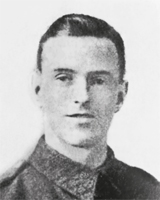
#1309 Sapper Edwin Victor Hatch
1/1ST CHESHIRE FIELD COMPANY, ROYAL ENGINEERS
EDWIN HATCH WAS THE YOUNGEST son of four in his family, born in Bromborough Pool, Cheshire, in 1892. His occupation as a wood turner and machinist meant that when he enlisted in November 1915, he was an ideal candidate for a very particular type of role in the army. The Royal Engineers was always on the lookout for practically skilled young men and he found himself posted to a field company as a sapper. The Royal Engineer field companies could be asked to turn their hand, and their initiative, to almost anything in preparation for action, after it had subsided or as battle raged around them. He had only arrived on the Western Front in the middle of May and as the Somme offensive began, the 1/1st Cheshire Field Company arrived in the area on 6th July.

Sapper Edwin Hatch. (Authors’ collection)
Since then their backbreaking work had epitomised the diversity of Edwin’s role. Since 7th July this company had been engaged in making notice boards and other joinery work, working on communication trenches, deepening other lines, forming dumps of materials for future use, attempting to blow up captured German field guns in Caterpillar Valley, constructing strong points, making bridges for horses and wagons and others sturdy enough to support artillery, cutting wire in front of old enemy lines and making or repairing tracks for traffic to get across the valley. In that time, three weeks, they had had just one day of rest and two standing by to be ready for action during which they had not been called upon.
When the next staged advance on the Somme went forward on 23rd July, the infantry on Edwin’s front made initial progress, but were eventually forced back, subjected to heavy counter-attacks. Whilst Horace Callaghan and the Australian contingent were clinging to their gains in Pozières, the Fourth Army to the south of them was flailing. Troops were attacking ground that they had never even seen before; this was doubly hard within a lot of units, where new drafts had arrived and the men lacked experience. Orders were received late, planning was ill conceived and start times varied randomly up and down the line, leaving the whole advance with a distinct lack of cohesion that meant it didn’t resemble a large-scale attack at all but lots of small ones.
The brigade that Edwin Hatch’s field company had been attached to had been told it would not be required during the assault of the 23rd, and so the sappers’ plan was to go out and resume work repairing the road between Carnoy and Montauban. As the sections were about to move off though, orders were received to recall all working parties of engineers, so that they could proceed to work on a half-finished trench at the northern end of Trônes Wood. They marched off in the early evening and met 200 infantry of Billy Congreve’s 76th Brigade, where they began work under shellfire. As darkness fell Edwin Hatch was mortally wounded. His fellow sappers managed to get him as far to the rear as Bernafay Wood, but he died of his wounds inside before they could find help. Edwin had survived just fifty-eight days at the front. A nearby chaplain oversaw his burial in the north-east corner of the wood, but Edwin Hatch’s grave was subsequently lost and if he was recovered again, his body was never identified. He is commemorated on the Thiepval Memorial, Pier & Face 8a/8d.